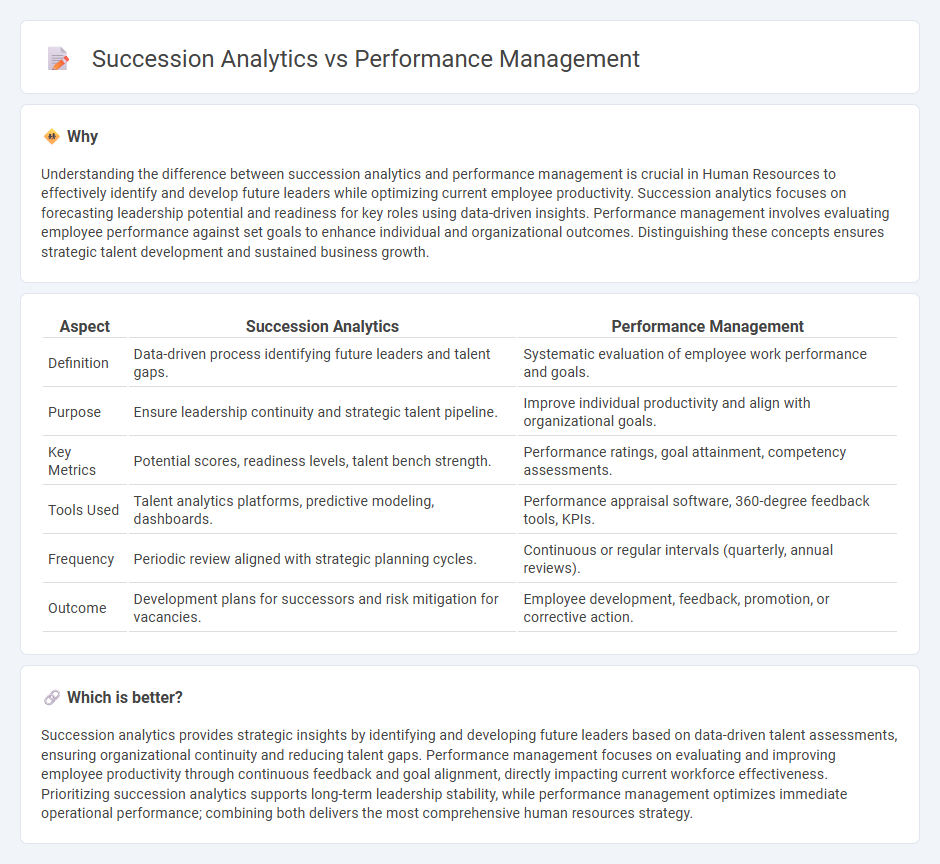
Succession analytics leverages data to identify and develop future leaders, ensuring organizational continuity and reducing talent gaps, while performance management focuses on evaluating and enhancing employee productivity and goal alignment. Both strategies utilize key metrics such as competency assessments and performance reviews to drive workforce optimization. Explore how integrating succession analytics with performance management can transform your HR strategy and boost long-term business success.
Why it is important
Understanding the difference between succession analytics and performance management is crucial in Human Resources to effectively identify and develop future leaders while optimizing current employee productivity. Succession analytics focuses on forecasting leadership potential and readiness for key roles using data-driven insights. Performance management involves evaluating employee performance against set goals to enhance individual and organizational outcomes. Distinguishing these concepts ensures strategic talent development and sustained business growth.
Comparison Table
| Aspect | Succession Analytics | Performance Management |
|---|---|---|
| Definition | Data-driven process identifying future leaders and talent gaps. | Systematic evaluation of employee work performance and goals. |
| Purpose | Ensure leadership continuity and strategic talent pipeline. | Improve individual productivity and align with organizational goals. |
| Key Metrics | Potential scores, readiness levels, talent bench strength. | Performance ratings, goal attainment, competency assessments. |
| Tools Used | Talent analytics platforms, predictive modeling, dashboards. | Performance appraisal software, 360-degree feedback tools, KPIs. |
| Frequency | Periodic review aligned with strategic planning cycles. | Continuous or regular intervals (quarterly, annual reviews). |
| Outcome | Development plans for successors and risk mitigation for vacancies. | Employee development, feedback, promotion, or corrective action. |
Which is better?
Succession analytics provides strategic insights by identifying and developing future leaders based on data-driven talent assessments, ensuring organizational continuity and reducing talent gaps. Performance management focuses on evaluating and improving employee productivity through continuous feedback and goal alignment, directly impacting current workforce effectiveness. Prioritizing succession analytics supports long-term leadership stability, while performance management optimizes immediate operational performance; combining both delivers the most comprehensive human resources strategy.
Connection
Succession analytics and performance management are interconnected through their use of employee data to identify high-potential talent and forecast future leadership needs. By analyzing performance metrics, organizations can map individual strengths and development areas, enabling targeted succession planning that aligns with strategic goals. This integration enhances workforce agility and ensures a continuous pipeline of qualified candidates for critical roles.
Key Terms
**Performance Management:**
Performance management involves continuous processes of setting objectives, monitoring employee progress, and providing feedback to enhance individual and organizational productivity. It utilizes real-time performance data and behavioral metrics to identify strengths, address skill gaps, and align workforce efforts with strategic goals. Explore how integrating advanced performance management techniques can drive sustained business success.
Goal Setting
Performance management emphasizes goal setting to enhance employee productivity, aligning individual objectives with organizational targets through measurable performance indicators. Succession analytics uses goal setting data to identify high-potential employees and forecast leadership readiness, ensuring strategic talent pipeline development. Explore how integrating goal setting within both frameworks can optimize workforce planning and leadership growth.
Feedback
Performance management emphasizes continuous feedback to enhance employee skills and productivity, using tools like real-time evaluations and goal tracking systems. Succession analytics leverages feedback data to identify high-potential candidates and predict leadership readiness, integrating performance trends and competency assessments. Explore how feedback-driven strategies in both disciplines can optimize workforce development and leadership planning.
Source and External Links
What Is Performance Management? The Complete Guide - AIHR - Performance management is an ongoing process where managers and employees regularly communicate to assess job responsibilities, set clear goals, and provide continuous feedback to foster growth and align individual performance with organizational objectives.
Performance Management Cycle - OPM - The performance management cycle includes planning work and setting expectations, continually monitoring progress, developing employee skills, periodically rating performance, and rewarding good performance as part of a continuous, systematic approach.
Performance management that puts people first - McKinsey - Effective performance management systems focus on continuous development, clarity in career growth, and aligning individual and team goals with organizational strategy, which can significantly enhance company performance and employee retention.
 dowidth.com
dowidth.com